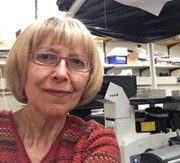Colloquia & Guest Speakers
Liquid Crystals Under Two Extremes: High Power Laser Irradiation and Single - Photon Level
Svetlana Lukishova, Professor of Optics, The Institute of Optics
Monday, February 24, 2025
3:30 p.m.
Presented in Goergen 101 and on Zoom
Abstract
This talk on thermotropic liquid crystals will highlight the main trends and effects in this area beyond displays and spatial light modulators. Its first part will be devoted to studies of liquid crystals in high-power laser beams with diversity of nonlinear optical effects; the second part will outline experiments with these materials in quantum optics and nanophotonics.
HIGH-POWER LASERS and NONLINEAR OPTICS: The most important properties of liquid crystals for nonlinear optics are giant orientational optical nonlinearity, thermooptical coefficients, which are more than an order of magnitude higher than the thermooptical coefficients of conventional liquids, and their high birefringence. The dissolution of some dyes at low concentration leads to many nonthermal nonlinear optical effects with practical applications. Chiral nematic (cholesteric) liquid crystals, self-assembled in spiral structures, are used as photonic bandgap materials for circular polarized light, for instance, as the laser cavity mirrors and low threshold microlasers. Experiments on nonthermal unwinding of a cholesteric helix by the field of a light wave will be discussed in this talk among other nonlinear optical effects in different types of liquid crystals. High-laser-damage threshold, high-diameter birefringent optical elements made of liquid crystals in the Laboratory for Laser Energetics for laser fusion systems will be shown in this talk. Liquid crystal glassy polymers/oligomers expand the range of applications for these materials.
QUANTUM OPTICS and NANOPHOTONICS: Tailoring fluorescence properties of single emitters by liquid crystal structural environments will be outlined. Application of this research on single (antibunched) photon sources is quantum information technology. Results on measurements of single-photon transit times along the spectral bandedge of cholesteric mirrors using a Hong-Ou-Mandel interferometer will be presented. 4th generation of transparent optics made of photoaligned liquid crystals based on modulation of the Pancharatnam-Berry geometrical phase will be outlined including q-plates for creation of orbital angular momentum of light.
Biography

Professor Svetlana G. Lukishova was born in Moscow. She received her BS/MS (with highest honors) and PhD degrees from the Moscow Institute of Physics and Technology (FizTech) working at the P.N. Lebedev Physical Institute of the Russian Academy of Sciences. Her senior project on theoretical astrophysics was made at a Nobel Prize winner V.L. Ginzburg’s theory department. Her PhD thesis was supervised by P.P. Pashinin and Nobel Prize winner A.M. Prokhorov and involved spatial beam-profile and temporal pulse-shape control in laser-fusion systems.
After holding research positions in Russian scientific institutes and the Liquid Crystal Institute (Kent, OH), she joined The Institute of Optics, University of Rochester. After 30 years of experience with high-power laser systems and interaction of laser radiation with matter she moved to quantum nanophotonics, which is currently her main research area in addition to liquid crystals.
She served two terms as the topical (associate) editor of Optica OSA journal Optics Letters in the fields of nanophotonics, liquid crystals and nonlinear optics. She has approximately 250 publications including co-editing and chapters of two Springer books: “Self-focusing: Past and Present. Fundamentals and Prospects” (2009) and “Quantum Photonics: Pioneering Advances and Emerging Applications” (2019). Using four NSF grants she created the Quantum and Nano-Optics experimental educational facility used in several Institute of Optics classes. She directs the University of Rochester undergraduate program on the Certificate in Nanoscience and Nanoengineering, initially supported by NSF, with 50 awarded students.
